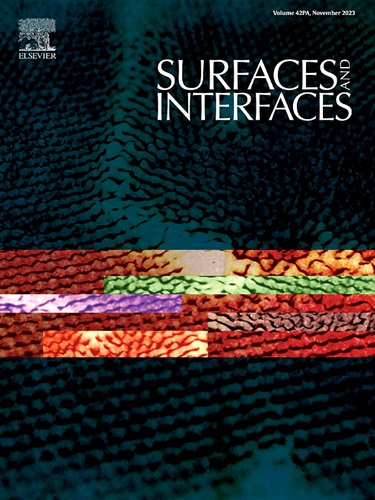Point defect scattering driven low lattice thermal conductivity in p-type Mg3Sb2 for mid-temperature thermoelectric applications
IF 5.7
2区 材料科学
Q2 CHEMISTRY, PHYSICAL
引用次数: 0
Abstract
Zintl-phase p-type magnesium antimonide (Mg3Sb2) is a promising mid-temperature (300- 900 K) thermoelectric (TE) material owing to its intrinsic low thermal conductivity, less toxicity, greater abundance, and compatibility. This present study focuses on enhancing the TE properties of Mg3Sb2 via the introduction of heavy elements Ge and Ag at lighter element Mg sites by two-step solid-state techniques. The influence of Ag-Ge modifies the band structure and strengthens the scattering of different wavelength phonons via various types of defects. This investigation indicates that (Ge, Ag) co-doping could significantly enhance the electrical conductivity (5328 S/m), and Seebeck coefficient (171.6 μV/K). The band structure modification leads to improving the overall power factor of 158.5 μW/mK2 at 753 K for Mg2.92Ge0.05Ag0.03Sb2. Simultaneously, the contribution of different types of defects strengthened the phonon transport, which leads to achieve a minimized lattice thermal conductivity of 0.42 W/mK for Mg2.92Ge0.05Ag0.03Sb2. Importantly, the enhanced power factor and low thermal conductivity resulting in a peak zT of 0.24 at 753 K for Mg2.92Ge0.05Ag0.03Sb2. Thus, the results highlight the effect of heavy element co-doping strategy modifies the band structure and strengthens the phonon scattering via defect engineering in p-type Mg3Sb2.

求助全文
约1分钟内获得全文
求助全文
来源期刊

Surfaces and Interfaces
Chemistry-General Chemistry
CiteScore
8.50
自引率
6.50%
发文量
753
审稿时长
35 days
期刊介绍:
The aim of the journal is to provide a respectful outlet for ''sound science'' papers in all research areas on surfaces and interfaces. We define sound science papers as papers that describe new and well-executed research, but that do not necessarily provide brand new insights or are merely a description of research results.
Surfaces and Interfaces publishes research papers in all fields of surface science which may not always find the right home on first submission to our Elsevier sister journals (Applied Surface, Surface and Coatings Technology, Thin Solid Films)
 求助内容:
求助内容: 应助结果提醒方式:
应助结果提醒方式:


